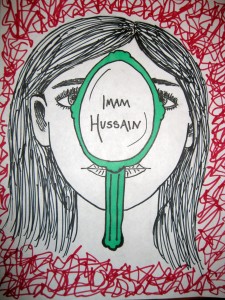Post Three
The Role of Women in the Taziyeh
(Week 5)
The meaning in this ink drawing is twofold. First, it is a nod to the Imam Hussain’s sacrifice. The mirror is green, as Hussain is often portrayed wearing green in the Iranian taziyeh as a symbol of good, while the background and surroundings of the woman are red an chaotic, representing the evilness and opposition of Hussain’s enemies. Hussain’s name is printed in the mirror to represent his symbol as a martyr and as an example of Muslim devotion, such that others should mirror is devotion to the faith, God, and the family of the Prophet Muhammad. Tied together, this brings the idea of redemptive suffering to the forefront; in mimicking the actions and devotion of Hussain and, by extension, the Prophet, one will experience worldly suffering and chaos but be rewarded with salvation in Heaven. The mirror faces the viewer rather than the woman to symbolize both audience participation in the story of Hussain (Iranian taziyeh) and the goal of personal devotion that mirrors that of Hussain.
Second, the woman behind the mirror represents the women in the taziyeh and the position of women in relation to God and the Prophet. The female characters in the Iranian taziyeh are examples of selflessness, devotion to God and to the Prophet’s family, and the mourning of the Shia community over Hussain’s sacrifice. As exemplified in Sir Lewis Pelly’s “The Miracle Play of Hasan and Hussein”, the women fulfill their roles as mourners and devotees. Hussein’s mother Fátima exclaims upon seeing her son’s dying body, “May I be offered for thy wounded, defaced body! Tell me, what dost thou wish thy mother to do now for thee?” (p. 102). Hussein’s sister mourns, “Alas! alas! woe to me! My Husain is gone from me! Alas! alas! the arrow of my heart is shot away from the hand!” and “see thy daughters prisoners of sorrow” (p. 93). The position of the female behind the mirror reflects her submission to the will of God and the Prophet’s family, while her presence in that of Hussain’s name represents the religious significance of the female gender in Islam. Women are viewed as having the qualities (submission, complete emotional devotion) required and most appropriate to relate to the Prophet and to become one with God (an idea central in bridal symbolism of the soul’s union with God).







Recent Comments